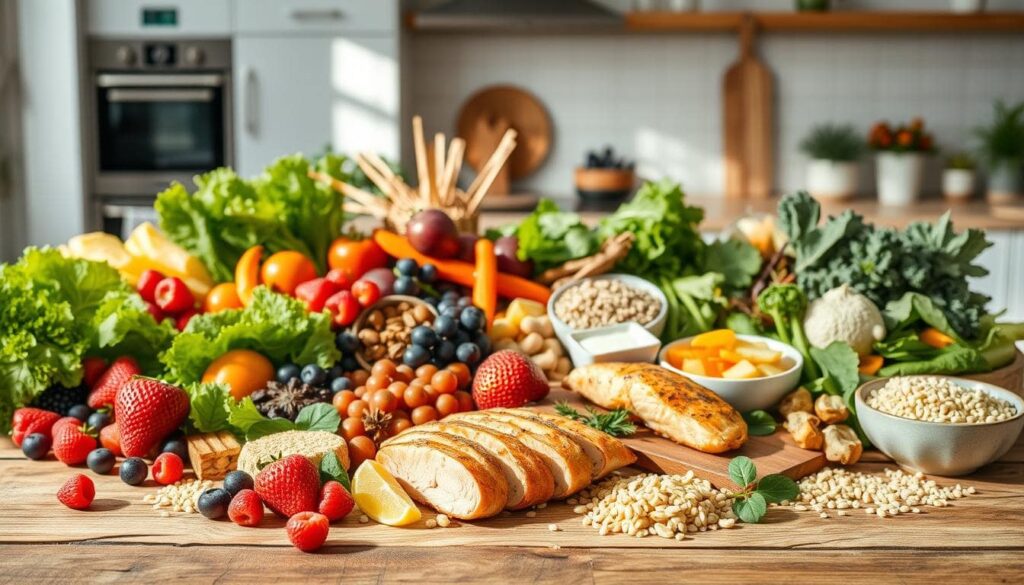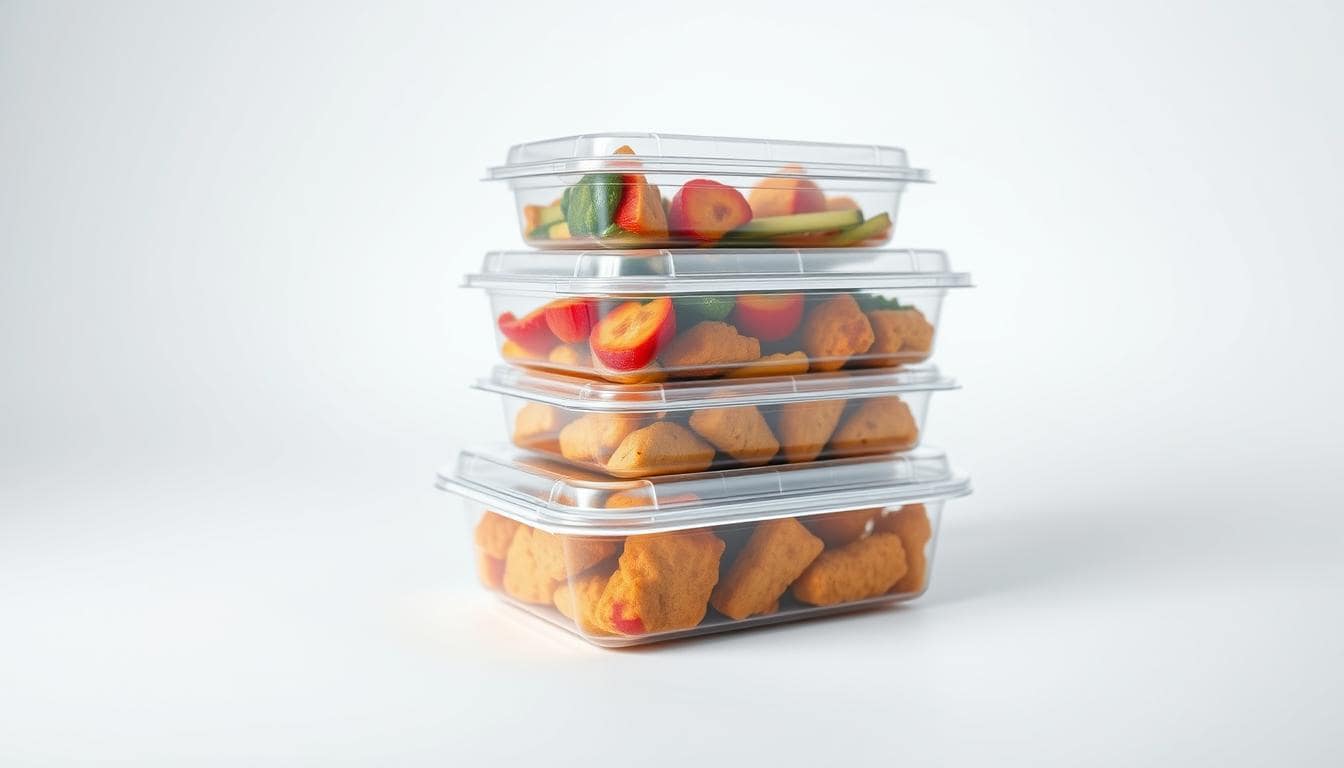I came across some research findings recently that totally fascinated me. I believe I should pass them on to you. Placing food in plastic containers may enhance the risk of heart failure.
While doing research, I learned that plastic containers are dangerous for our health. They can particularly damage our heart health. According to the study, chemicals in these containers can penetrate our food, increasing the risk of heart failure. plastic Food Containers
Plastic Food Takeaway Containers Can Raise Heart Failure Risk: Study
Three rectangular plastic food takeaway containers stacked on top of each other, with tightly sealed lids, sitting on a plain white surface. The containers are transparent, giving a glimpse of the interior – a multicolored variety of cooked meals and snacks.
The lighting is diffused and soft, giving a clean, clinical environment. The angle is slightly raised, offering a bird’s-eye view that accentuates the uniform shape and size of the containers. The focus is tight, highlighting the containers’ solid composition and the rich colors of the food inside.
The connection between plastic containers and heart failure is what we must note. I am going to dig deeper into this issue. Looking at the newest research, we can know more about the risks. In doing so, we can take action to reduce our risk of heart failure.
The Shocking Link Between Plastic Containers and Heart Health

Investigating the health hazards of plastic containers, I came across some appalling facts. Research has established a connection between the use of plastics and heart disease. Takeout containers, especially, raise the risk of heart disease. According to a study, plastic chemicals can enter our food and hurt our hearts.https://wenewsenglish.pk/plastic-food-takeaway-containers-can-increase-risk-of-heart-failure-study/
This study is of great concern. We must understand the risks of plastic containers and how to prevent them. With safer containers, we can reduce our risk of heart disease.
Some key study findings are:
Plastic containers release chemicals into food, particularly when cooked.
These chemicals are associated with increased heart disease and other health risk.
Using glass or stainless steel containers can reduce chemical exposure.
It is important to learn about the dangers of plastic and takeout containers. By educating ourselves and making wise decisions, we are able to preserve our heart health and reduce risk of heart disease.
Plastic Food Takeaway Containers May Up Heart Failure Risk: What Study Says
Recent studies identify a strong relationship between plastic food containers and cardiovascular health. Plastic food containers dangers are increasingly visible. It is essential to understand how they contribute to increasing the risk of heart failure.
Recent studies have unveiled the plastic food container dangers. It identifies the way they are damaging our blood vessel and heart.
The summary points of the study are:
More exposure to chemicals such as BAP and phthalates that can migrate into foods and beverages
Possible harm to the heart and arteries, increasing the risk of heart failure
A connection between the use of plastic containers and a greater risk of high blood pressure, a significant risk factor for heart disease
plastic containers and heart health

A glass tabletop has an arrangement of plastic takeout containers in different shapes and sizes. Various colorful foods fill the containers, which represent a standard takeout meal. In the foreground, a human heart model is prominently set, chambers and valves exposed. Gentle, soft lighting in the scene casts gentle shadows. The containers and the heart are the centers of attention, and a slightly fuzzy background implies a clinic or medical environment.
The overall tone is reflective, calling attention to the possible connection between plastic containers used for food and heart health. The arrangement makes the viewer look at the combination of the mundane take-out food and the anatomical heart model, prompting introspection about the research results.
To reduce the risks of plastic food containers, we need to be mindful of the threats. We should opt for safer alternatives to safeguard our heart health. In this manner, we can reduce the risk of heart failure.
Protecting Yourself: Safe Alternatives to Plastic Food Containers
As we know more about plastic food containers, we realize their health consequences. It’s important to have safe alternatives to reduce heart failure risk. The research on takeaway containers indicates smart choices in food storage.
Using glass and stainless steel is an intelligent choice. They are secure, durable, and excellent for food storage. Minor adjustments in our way of life will reduce plastic usage and risk of heart failure.
Practical Tips for a Healthier Lifestyle
Use glass or stainless steel containers for packing lunches and food storage
Refrain from microwaving food in plastic containers since this makes chemicals leach into food
opt for restaurants that use eco-friendly packaging or offer plastic-free alternatives
Being careful with our food choices and storage can greatly help. The study on plastic containers warns us of dangers. It’s our turn to choose wisely for our health.
plastic food containers alternative

1.A well-lit, close-up shot of a variety of sustainable, eco-friendly food storage containers arranged on a clean, minimalist surface.
2.The foreground boasts a colorful mix of glass jars, stainless steel tiffin’s, bamboo bowls, and silicone bags, each with clean, contemporary designs.
3.The middle ground displays the containers being used, packed with fresh, wholesome ingredients.
4.The background subtly suggests a peaceful, nature-based environment, maybe with an undertone of greenery or wood tones, with a warm, simple, and eco-friendly feel.
5.The overall tone is one of intentionality, functionality, and devotion to sustainable living.
Conclusion: Taking Action for Heart Health
Recent research has indicated that plastic containers used for food can be detrimental to our heart health. But, fortunately, there are simple steps we can take in order to be safe. Using glass or stainless steel containers will keep us away from dangerous chemicals.
These results associate plastic use with an increased risk of heart failure. Heart disease is a leading cause of death worldwide. By sharing this with others, we can encourage them to make healthier decisions for their heart.https://seherblogging.com/just-24-hours-without-sleep-linked-to-obesity/
Examine your food storage containers in your home and opt for safer alternatives. This simple switch can have a significant impact. We can all combat plastic pollution and build a healthier world for all.
FAQ
What is the connection between plastic food containers and heart failure risk?
Recent research indicates that plastic food container chemicals, such as bisphenol A (BPA) and phthalates, increase heart failure risk. These chemicals disrupt the normal function of the heart. This may cause heart disease.
How do the chemicals in plastic containers influence the heart?
The plastics in containers interfere with the hormones in the body. It leads to inflammation and oxidative stress. It injures blood vessels and makes it difficult for the heart to be able to circulate blood. It also increases the risk of high blood pressure and other heart conditions.
Which are the main chemical compounds contained in food containers that are responsible for heart disease?
The main chemicals to worry about are bisphenol A (BPA) and phthalates. They’re found in many plastic food containers and packaging. These chemicals mess with the heart’s function and increase heart disease risk.
What are some safe alternatives to plastic food containers?
Safe alternatives include glass, stainless steel, and ceramic. These materials don’t have the harmful chemicals found in plastic. They’re better for your health and the environment.
How can I minimize my risk of heart failure when buying takeout?
To minimize heart failure risk when buying takeout, steer clear of single-use plastic containers. opt for restaurants that use earth-friendly packaging or bring your own containers. This limits exposure to toxic plastic chemicals.
https://seherblogging.com/my-top-tips-to-improve-lifestyle-and-health-toda/









